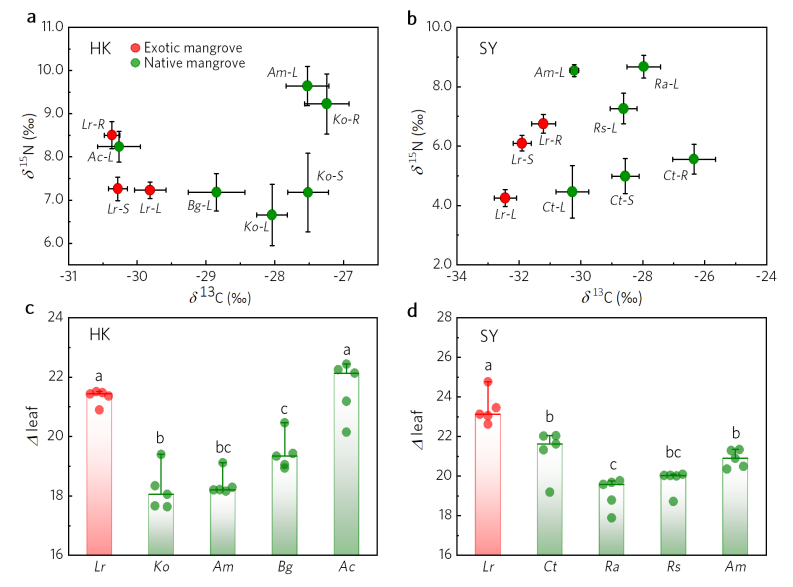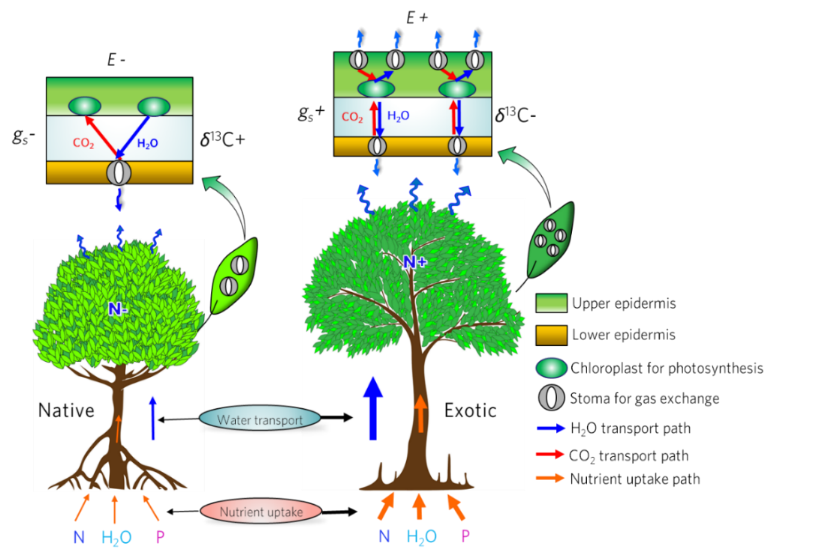Mangroves, as one of the ecosystems with the highest soil carbon density and carbon fixation rate in the world, have extremely high value for ecological service. Affected by human activities, the mangrove area is rapidly decreasing at a rate of 1-2% per year. In order to restore the ecological function of mangroves, China and many other countries have carried out a large number of ecological reforestation projects with the introduction of exotic mangrove species as the main approach. However, to rapidly increase the coverage area of mangroves, many reforestation projects have introduced fast-growing exotic species, ignoring the potential invasiveness risk of exotic mangrove species to native mangrove species.
With regard to the invasiveness of exotic mangrove species, Professor Lin Hui’s Research Group of Tsinghua University has attempted to reveal possible micro-mechanisms for the fast expansion of L. racemosa, using the data on leaf stomata straits, gas-exchange parameters, stable isotope ratios, carbon-nitrogen allocation from L. racemosa and the adjacent native mangroves in Hainan Island, China. The related research has been published online as a paper titled “The linkages between stomatal physiological traits and rapid expansion of exotic mangrove species (Laguncularia racemosa) in new territories” in Frontiers in Marine Science, a journal in Marine and Freshwater Biology I.
As a newly introduced "star" species, Laguncularia racemosa (L. racemosa) was the most widely used exotic mangrove species for reforestation due to its high environmental adaptability and fast-growing character. However, with the passage of time, the invasiveness of L. racemose has begun to appear gradually, but no consensus has been reached on the plant physiological mechanism of its rapid expansion. The Research Group has found that L. racemosa has higher density but smaller size stoma, which not only enhances the stomatal conductance, but also shortens the diffusion path of carbon dioxide, thus improving the photosynthetic rate. In addition, the higher stomatal density of L. racemosa can obviously promote transpiration, accelerate water transport and nutrient absorption, and thus meet the demand for nutrients and water for rapid growth. Evidences from δ13C and carbon and nitrogen distribution in leaves have further proven (Fig. 1) that the inherent water use efficiency (iWUE) of L. racemosa is low, but the photosynthesis rate is significantly higher than that of native mangrove species. The results show that compared with the adjacent local mangroves, the stomatal morphological and physiological characteristics of L. racemosa have a strong influence on its fast growth, which provides a new perspective for the rapid expansion mechanism of exotic mangrove species (Fig. 2).
The results show that L. racemosa has certain invasive potential in the native mangrove habitat. It is suggested that exotic mangrove plants such as L. racemosa should be cautiously used in mangrove artificial afforestation or reforestation projects. Many institutions, such as the State Forestry and Grassland Administration, expressly prohibit the use of exotic mangrove plants, such as Sonneratia apetala, in mangrove nature reserves or mangrove ecological reforestation projects funded by the State Allocation Fund, in efforts to better protect the native mangrove plants in China and the marine biodiversity that depends on mangrove plants.

Fig. 1 The value of δ13C, δ15N, and ⊿leaf in native and exotic mangroves.

Fig. 2 Conceptional diagram for linking stomatal traits to foliar gas exchange performance in native mangroves (right) and exotic mangrove (left).
Bai Jiankun, a Ph.D graduate from the DESS, Tsinghua University is the first author of the paper, Prof. Lin Hui of the DESS is the corresponding author, and other co-authors include Prof. Zhu Xiaoshan of Hainan University, doctoral students Meng Yuchen and Gou Ruikun of the DESS, and master’s graduate Dai Zheng of Tsinghua Shenzhen International Graduate School. This work has been supported by (grant no. 2017FY100703), and the National Key R&D Program of China (grant no. 2019YFA0606604), and the National Natural Science Foundation of China (grant no. 41877352).
Paper link: https://www.frontiersin.org/articles/10.3389/fmars.2023.1136443/full
Written by Bai Jiankun and Lin Guanghui
Edited by Wang Jiayin
Reviewed by Zhang Qiang